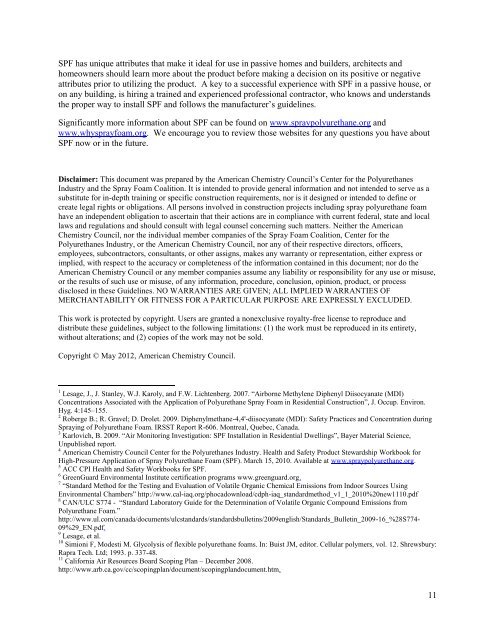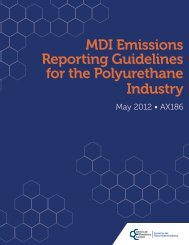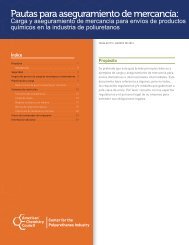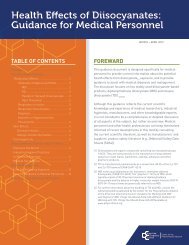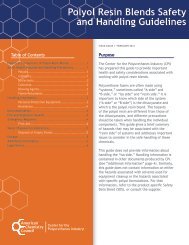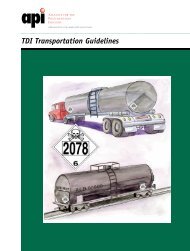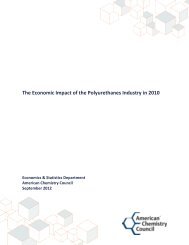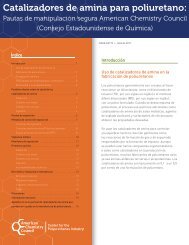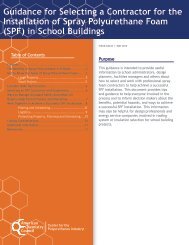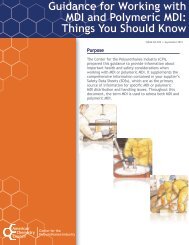Spray Polyurethane Foam: Benefits for Passive Houses
Spray Polyurethane Foam: Benefits for Passive Houses
Spray Polyurethane Foam: Benefits for Passive Houses
Create successful ePaper yourself
Turn your PDF publications into a flip-book with our unique Google optimized e-Paper software.
SPF has unique attributes that make it ideal <strong>for</strong> use in passive homes and builders, architects and<br />
homeowners should learn more about the product be<strong>for</strong>e making a decision on its positive or negative<br />
attributes prior to utilizing the product. A key to a successful experience with SPF in a passive house, or<br />
on any building, is hiring a trained and experienced professional contractor, who knows and understands<br />
the proper way to install SPF and follows the manufacturer’s guidelines.<br />
Significantly more in<strong>for</strong>mation about SPF can be found on www.spraypolyurethane.org and<br />
www.whysprayfoam.org. We encourage you to review those websites <strong>for</strong> any questions you have about<br />
SPF now or in the future.<br />
Disclaimer: This document was prepared by the American Chemistry Council’s Center <strong>for</strong> the <strong>Polyurethane</strong>s<br />
Industry and the <strong>Spray</strong> <strong>Foam</strong> Coalition. It is intended to provide general in<strong>for</strong>mation and not intended to serve as a<br />
substitute <strong>for</strong> in-depth training or specific construction requirements, nor is it designed or intended to define or<br />
create legal rights or obligations. All persons involved in construction projects including spray polyurethane foam<br />
have an independent obligation to ascertain that their actions are in compliance with current federal, state and local<br />
laws and regulations and should consult with legal counsel concerning such matters. Neither the American<br />
Chemistry Council, nor the individual member companies of the <strong>Spray</strong> <strong>Foam</strong> Coalition, Center <strong>for</strong> the<br />
<strong>Polyurethane</strong>s Industry, or the American Chemistry Council, nor any of their respective directors, officers,<br />
employees, subcontractors, consultants, or other assigns, makes any warranty or representation, either express or<br />
implied, with respect to the accuracy or completeness of the in<strong>for</strong>mation contained in this document; nor do the<br />
American Chemistry Council or any member companies assume any liability or responsibility <strong>for</strong> any use or misuse,<br />
or the results of such use or misuse, of any in<strong>for</strong>mation, procedure, conclusion, opinion, product, or process<br />
disclosed in these Guidelines. NO WARRANTIES ARE GIVEN; ALL IMPLIED WARRANTIES OF<br />
MERCHANTABILITY OR FITNESS FOR A PARTICULAR PURPOSE ARE EXPRESSLY EXCLUDED.<br />
This work is protected by copyright. Users are granted a nonexclusive royalty-free license to reproduce and<br />
distribute these guidelines, subject to the following limitations: (1) the work must be reproduced in its entirety,<br />
without alterations; and (2) copies of the work may not be sold.<br />
Copyright © May 2012, American Chemistry Council.<br />
1<br />
Lesage, J., J. Stanley, W.J. Karoly, and F.W. Lichtenberg. 2007. “Airborne Methylene Diphenyl Diisocyanate (MDI)<br />
Concentrations Associated with the Application of <strong>Polyurethane</strong> <strong>Spray</strong> <strong>Foam</strong> in Residential Construction”, J. Occup. Environ.<br />
Hyg. 4:145–155.<br />
2<br />
Roberge B.; R. Gravel; D. Drolet. 2009. Diphenylmethane-4,4'-diisocyanate (MDI): Safety Practices and Concentration during<br />
<strong>Spray</strong>ing of <strong>Polyurethane</strong> <strong>Foam</strong>. IRSST Report R-606. Montreal, Quebec, Canada.<br />
3<br />
Karlovich, B. 2009. “Air Monitoring Investigation: SPF Installation in Residential Dwellings”, Bayer Material Science,<br />
Unpublished report.<br />
4<br />
American Chemistry Council Center <strong>for</strong> the <strong>Polyurethane</strong>s Industry. Health and Safety Product Stewardship Workbook <strong>for</strong><br />
High-Pressure Application of <strong>Spray</strong> <strong>Polyurethane</strong> <strong>Foam</strong> (SPF). March 15, 2010. Available at www.spraypolyurethane.org.<br />
5<br />
ACC CPI Health and Safety Workbooks <strong>for</strong> SPF.<br />
6<br />
GreenGuard Environmental Institute certification programs www.greenguard.org.<br />
7<br />
“Standard Method <strong>for</strong> the Testing and Evaluation of Volatile Organic Chemical Emissions from Indoor Sources Using<br />
Environmental Chambers” http://www.cal-iaq.org/phocadownload/cdph-iaq_standardmethod_v1_1_2010%20new1110.pdf<br />
8<br />
CAN/ULC S774 - “Standard Laboratory Guide <strong>for</strong> the Determination of Volatile Organic Compound Emissions from<br />
<strong>Polyurethane</strong> <strong>Foam</strong>.”<br />
http://www.ul.com/canada/documents/ulcstandards/standardsbulletins/2009english/Standards_Bulletin_2009-16_%28S774-<br />
09%29_EN.pdf.<br />
9<br />
Lesage, et al.<br />
10<br />
Simioni F, Modesti M. Glycolysis of flexible polyurethane foams. In: Buist JM, editor. Cellular polymers, vol. 12. Shrewsbury:<br />
Rapra Tech. Ltd; 1993. p. 337-48.<br />
11<br />
Cali<strong>for</strong>nia Air Resources Board Scoping Plan – December 2008.<br />
http://www.arb.ca.gov/cc/scopingplan/document/scopingplandocument.htm.<br />
11


